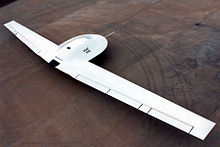Lockheed Martin RQ-3 DarkStar: Difference between revisions
No edit summary |
|||
| Line 98: | Line 98: | ||
{{commons|RQ-3 Dark Star|RQ-3 Dark Star}} |
{{commons|RQ-3 Dark Star|RQ-3 Dark Star}} |
||
* [http://www.dfrc.nasa.gov/Gallery/Photo/Tier3-/index.html DarkStar Tier III- from NASA Dryden Flight Center] |
* [http://www.dfrc.nasa.gov/Gallery/Photo/Tier3-/index.html DarkStar Tier III- from NASA Dryden Flight Center] |
||
* [http://www.fas.org/irp/program/collect/darkstar.htm] |
|||
[[Category:UAVs and drones]] |
[[Category:UAVs and drones]] |
||
Revision as of 09:57, 25 June 2008
The RQ-3 DarkStar (known as Tier III- during development) unmanned aerial vehicle (UAV) was operated by the US Air Force. Its first flight was on March 29, 1996. The Department of Defense terminated DarkStar in January 1999, after determining the UAV was neither aerodynamically stable nor meeting cost and performance objectives. [1] The DarkStar was derisively given the moniker "Dark Spot" in light of its poor performance after a crash.[citation needed]
The RQ-3 DarkStar was designed as a "high-altitude endurance UAV", and incorporated stealth technology to make it difficult to detect. The DarkStar was fully autonomous: it could take off, fly to its target, operate its sensors, transmit information, return and land without human intervention. Human operators, however, could change the DarkStar's flight plan and sensor orientation through radio or satellite relay. The RQ-3 carried either an optical sensor or radar, and could send digital information to a satellite while still in flight.
The first prototype made its first flight on March 29, 1996, but its second flight, on April 22, 1996, ended in a crash shortly after takeoff. A modified, more stable design (the RQ-3A) first flew on June 29, 1998, and made a total of five flights. Two additional RQ-3As were built, but never made any flights before program cancellation. The first of these (A/V #3) is now on display in the Great Gallery of the Museum of Flight in Seattle, Washington.
Although purportedly terminated on January 28, 1999, it was reported in April 2003 that the RQ-3 was still in development as a black project.[1] The size and capabilities were reported to have increased somewhat. It was further alleged that the first such example had been used in the 2003 invasion of Iraq.[1] There has been no independent confirmation.
The "R" is the Department of Defense designation for reconnaissance; "Q" means unmanned aircraft system. The "3" refers to it being the third of a series of purpose-built unmanned reconnaissance aircraft systems.

Specifications
| This aircraft article is missing some (or all) of its specifications. If you have a source, you can help Wikipedia by adding them. |
General characteristics


- Primary function: Reconnaissance
- Contractor: Lockheed Martin Skunkworks, Palmdale, California, and Boeing Company, Seattle, Washington.
- Powerplant: One Williams-Rolls FJ44-1A with 1,900 lbf (8.5 kN) thrust
- Empty Weight: 4,360 lb (1,980 kg)
- Max LoadedWeight: 8,500 lb (3,860 kg)
- Fuel capacity:
- Payload:
- System cost:
- Inventory:
Dimensions
- Length: 15 ft (4.6 m)
- Height: 3 ft 6 in (1.1 m)
- Wingspan: 69 ft (21.3 m)
Performance
- Cruising speed: 288 mph (464 km/h)
- Range: 575 mi (925 km)
- Service ceiling: 45,000 ft (13,500 m)
See also
Aircraft of comparable role, configuration, and era
- MQ-9 Reaper (originally known as the RQ-9 Predator B)
- Corax
- Dassault Neuron
- EADS Barracuda
Related lists
Sources
- Specifications and second and third paragraphs: Display information on exhibit at Museum of Flight in Seattle, Washington, USA.
References
- ^ a b Aviation Week & Space Technology. April, 2003.
